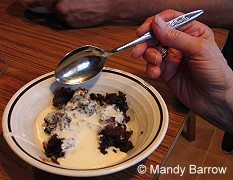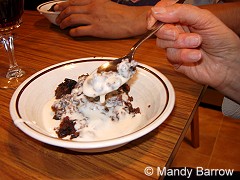|
Eating Etiquette
|
||||||
| Learn about Christmas in England from the children who live in Britain Christmas traditions why do what we do at chrsitmas time What should I do or not do when I am eating in Britain? The British generally pay a lot of attention to good table manners. Even young children are expected to eat properly with knife and fork. We eat most of our food with cutlery. The foods we don't eat with a knife, fork or spoon include sandwiches, crisps, corn on the cob, and fruit.
If you cannot eat a certain type of food or have some special needs, tell your host several days before the dinner party. If you are a guest, it is polite to wait until your host starts eating or indicates you should do so. It shows consideration. Always chew and swallow all the food in your mouth before taking more or taking a drink. Always say thank you when served something. It shows appreciation. You may eat chicken and pizza with your fingers if you are at a barbecue, finger buffet or very informal setting. Otherwise always use a knife and fork. When eating rolls, break off a piece of bread before buttering. Eating it whole looks tacky. On formal dining occasions it is good manners to take some butter from the butter dish with your bread knife and put it on your side plate (for the roll). Then butter pieces of the roll using this butter. This prevents the butter in the dish getting full of bread crumbs as it is passed around. In a restaurant, it is normal to pay for your food by putting your money on the plate the bill comes on.
When you have finished eating, and to let others know that you have, place your knife and folk together, with the prongs (tines) on the fork facing upwards, on your plate.
Never lick or put your knife in your mouth. It is impolite to start eating before everyone has been served unless your host says that you don't need to wait. Never chew with your mouth open. No one wants to see food being chewed or hearing it being chomped on. It is impolite to have your elbows on the table while you are eating. Don't reach over someone's plate for something, ask for the item to be passed. Never talk with food in your mouth. It is impolite to put too much food in your mouth. Never use your fingers to push food onto your spoon or fork. It is impolite to slurp your food or eat noisily. Never blow your nose on a napkin (serviette). Napkins are for dabbing your lips and only for that. Never take food from your neighbours plate. Never pick food out of your teeth with your fingernails.
It is ok to pour your own drink when eating with other people, but it is more polite to offer pouring drinks to the people sitting on either side of you. It is ok to put milk and sugar in your tea and coffee or to drink them both without either.
We eat continental style, with fork in the left hand and the knife in the right (or the other way round if you are left handed). At the top of your plate will be a dessert spoon and dessert fork. If you are eating at a formal dinner party, you will come across many knives and forks. Start with the utensils on the outside and work your way inward with each subsequent course
The fork is held in the left hand and the knife in the right. If you have a knife in one hand, it is wrong to have a fork in the other with the prongs (tines) pointed up. Hold your knife with the handle in your palm and your folk in the other hand with the prongs pointing downwards.
When eating in formal situations, rest the fork and knife on the plate between mouthfuls, or for a break for conversation. If you put your knife down, you can turn your fork over. It's correct to change hands when you do this, too, so if you are right handed you would switch and eat with the fork in your right hand.
If it is your sole eating instrument, the fork should be held with the handle between the index finger and the thumb and resting on the side of your middle finger.
When eating soup, tip the bowl away from you and scoop the soup up with your spoon. Soup should always be taken (without slurping of course) from the side of the spoon, and not from the 'end' as in most of the rest of Europe.
To be very polite, peas should be crushed onto the fork - a fork with the prongs pointing down. The best way is to have load the fork with something to which they will stick, such as potato or a soft vegetable that squashes easily onto the fork. It's sometimes easier to put down your knife and then switch your fork to the other hand, so you can shovel the peas against something else on the plate, thus ensuring they end up on your fork. The fork should not be used as a scoop but held so that the points of the tines face
To eat dessert, break the dessert with the spoon, one bite at a time. Push the food with the fork (optional) into the spoon. Eat from the spoon. (Fork in left hand; spoon in right.)
The golden rule is that a napkin should never be used to blow your nose on. This is a definite no-no. Napkins should be placed across the lap - tucking them into your clothing may be considered 'common'.
Say: "I'm sorry, but it seems that 'my eyes are bigger than my stomach'. or "I'm sorry. It was so delicious but I am full". The main thing is not to offend your host Other pages on our web site about food or manners and etiquette For information about the food we eat, visit our food pages. For more information about manners and etiquette: Visit Social Customs and Dos and Don'ts in Britain Questions (or statements) sent to us by visitors to our website
© Copyright Mandy Barrow 2013 Mandy is the creator of the Woodlands Resources section of the Woodlands Junior website. Mandy left Woodlands in 2003 to work in Kent schools as an ICT Consulatant. Woodlands Junior Homework Help new website
|
© Copyright Mandy Barrow 2013
 © Copyright - please read © Copyright - please read All the materials on these pages are free for homework and classroom use only. You may not redistribute, sell or place the content of this page on any other website or blog without written permission from the Mandy Barrow. |
Mandy is the creator of the Woodlands Resources section of the Woodlands Junior website.
The two websites projectbritain.com and primaryhomeworkhelp.co.uk are the new homes for the Woodlands Resources.
Mandy left Woodlands in 2003 to work in Kent schools as an ICT Consulatant.
She now teaches computers at The Granville School and St. John's Primary School in Sevenoaks Kent.
Woodlands Homework Help new website
customs traditions britain, scotland customs and traditions, traditional british christmas dinner, christmas customs traditions, christmas traditions, british culture customs traditions, british christmas customs, british christmas carols, british christmas crackers, british christmas pudding,british christmas trees, british christmas dinner, british celebrate christmas, british royal family, chrsitmas traditions, christmas customs, england, wales, scotland, Christmas Celebrations, british traditions, british customs, british culture, December, Christmas, food, christmas dinner, mince pies, advent, christmas eve, christmas day, boxing day, 12 days of christmas, new year, christmas pudding, christmas cake, christmas carols, christmas cards, christmas stocking, pantomime, santa claus, st nicholas, christmas presents, christmas crackers, christmas trees, mistletoe, holly, ivy














